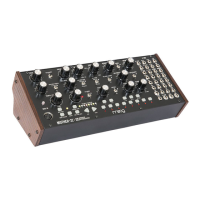13
VCF MODULATION
VCF MOD SOURCE
This switch is used to determine whether the LFO or EG is being sent to
the VCF MOD AMOUNT control.
VCF MOD AMOUNT
This variable control determines how much the modulation source changes
the Filter Cutoff frequency.
VCF MOD POLARITY
This switch is used to determine whether the VCF modulation has a positive or
negative effect on the Filter Cutoff frequency. For example, instead of using
the Attack portion of the EG to boost the Filter Cutoff frequency, inverting the
polarity will allow the Attack portion to lower the Filter Cutoff frequency.
TIP: When modulating the Filter Cutoff with the EG and the Polarity switch set
to (+), turn the CUTOFF control down to the minimum desired frequency. In this
case, modulation from the EG adds to this setting. When modulating the Filter
Cutoff with the EG and the Polarity switch is set to (-), turn the CUTOFF control up to the maximum
desired frequency. In this case, modulation from the EG subtracts from this setting.
EG (ENVELOPE GENERATOR)
Envelope Generators (EGs) create a signal that adds motion to a sound after a note is played. The EG
is started by a Gate or MIDI Note On message. Once started, their shape in time is determined by the
ATTACK, DECAY, and SUSTAIN controls.
ATTACK
The ATTACK control is used to specify the time it takes for the Envelope signal
to ascend from zero to its maximum level. Fast attacks are useful for creating
plucked sounds, while slow attacks are more useful for creating bowed string
sounds and swells.
Turn the ATTACK control to the left for faster attack times, and to the right for
slower attack times.

